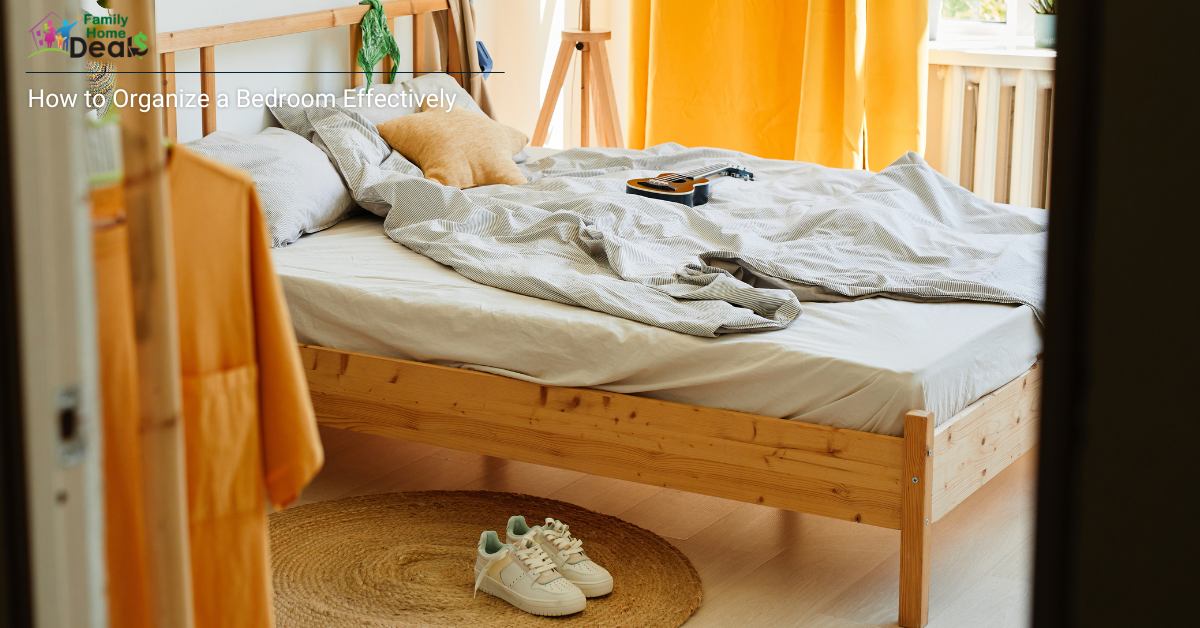
Ever felt overwhelmed by the clutter in your bedroom? Or maybe you’ve spent precious morning minutes looking for your favorite shirt buried under a pile of clothes? Organizing your bedroom doesn’t just make it look neat; it can also save you time and reduce stress. Imagine starting your day in a peaceful, organized space where everything is easy to find. If this sounds like a dream come true, keep reading! We’re about to dive into some practical tips and ideas on how to organize a bedroom that will transform your space into a tidy, tranquil retreat.
Organizing a bedroom might seem like a daunting task, but with the right approach, it can be surprisingly simple and even enjoyable. From decluttering and smart storage solutions to maintaining your newly organized space, we’ve got you covered. Whether you’re dealing with a small room or a spacious master suite, these tips will help you create a bedroom that’s not just functional but also a relaxing sanctuary.
How to Organize a Bedroom Effectively
1. Declutter First
Before you can start organizing, you need to declutter. This means getting rid of anything you don’t need, use, or love.
Tips for Decluttering:
Sort through your clothes: Dividing clothes into three piles—keep, donate, and discard—might seem straightforward, but it requires some introspection and honesty about your habits and preferences.
- Assess Usefulness: Evaluate each item based on how often you wear it and if it fits your current lifestyle. Clothes that no longer fit or are outdated can be donated or discarded.
- Seasonal Sorting: Separate your clothes by season. This will help you see what you have for the current season and what can be stored away.
- Repair or Recycle: For clothes that need minor repairs, create a separate pile. For those beyond repair, consider recycling the fabric if possible.
Tackle other items: Going beyond clothes, other items in your bedroom also need attention. Apply the same keep, donate, and discard rule to streamline your space.
- Books: Keep only those books you plan to read again or that have sentimental value. Donate or sell the rest. Consider using e-books to save physical space.
- Accessories: This includes jewelry, belts, and scarves. Only keep those that you regularly wear and love.
- Shoes: Evaluate your shoe collection similarly. Shoes that are worn out or no longer fit your style should be donated or discarded.
Sentimental items: Sentimental items can be the hardest to declutter because of the emotions attached to them. However, they can still be managed without cluttering your space.
- Memory Box: Designate a small box for truly special items. This helps limit the space they occupy while preserving memories.
- Photographs and Letters: Consider digitizing old photographs and letters. This way, you keep the memories without taking up physical space.
- Display Selectively: Choose a few special items to display in your room. Rotate these items periodically to keep the display fresh and meaningful.
2. Optimize Closet Space
Your closet is prime real estate for storage. Making the most of it can transform your bedroom organization. With a few strategic adjustments, you can maximize space and maintain an organized, accessible closet.
Closet Organization Ideas:
Use Uniform Hangers: Uniform hangers save space and give your closet a neat, organized look. They also prevent clothes from slipping off and getting wrinkled.
- Slim Profile Hangers: Opt for slim, non-slip hangers to maximize space. These are especially good for small closets.
- Wooden Hangers: For a more polished look, use wooden hangers for heavier items like coats and suits. They provide better support and maintain the shape of your clothes.
- Matching Aesthetic: Using the same type and color of hangers creates a cohesive and visually appealing closet.
Add Shelves or Dividers: Shelves and dividers can help separate different items, making everything easier to find and keeping your closet more organized.
- Adjustable Shelves: Install adjustable shelves to accommodate items of various sizes. This flexibility helps you make the most of your space.
- Shelf Dividers: Use dividers to keep stacks of clothes, bags, or linens tidy and prevent them from toppling over.
- Shoe Racks: Place shoe racks at the bottom of your closet to organize your footwear. Consider stackable or tiered shoe shelves to save space.
Double Up Hanging Space: Maximize vertical space by doubling up your hanging rods. This is particularly useful for separating different types of clothing.
- Double Hanging Rods: Install a second rod below your existing one. Use the top rod for longer items like dresses and coats, and the bottom rod for shorter items like shirts and pants.
- Hooks and Pegs: Use hooks or pegs on the side walls of your closet for hanging accessories, belts, or scarves.
- Extendable Rods: Consider extendable rods that can be adjusted based on your needs. They are versatile and can be repositioned as your storage requirements change.
Use Clear Bins: Clear bins are excellent for storing out-of-season clothes or items you don’t use frequently. They keep everything visible and accessible.
- Labeling: Even though the bins are clear, labeling them helps you quickly identify the contents. Use consistent labeling for a tidy look.
- Stackable Bins: Opt for stackable bins to save space. They can be easily rearranged as needed.
- Accessible Placement: Store bins on high shelves for items you rarely use, and keep frequently used items within easy reach.
3. Smart Storage Solutions
Smart storage solutions can make a big difference in how organized your bedroom looks and feels. By incorporating these ideas, you can maximize space and create a clutter-free environment.
Storage Tips:
Under-Bed Storage: Utilize the space under your bed for storing shoes, off-season clothes, or extra bedding. This often-overlooked area can provide significant storage without taking up additional space in your room.
- Clear Containers: Use clear plastic containers to store items under the bed. Clear containers make it easy to see what’s inside without having to open them.
- Rolling Bins: Opt for rolling bins for easy access. They glide smoothly under the bed and can be pulled out with minimal effort.
- Vacuum Storage Bags: For bulky items like bedding, vacuum storage bags can save space by compressing them. These are especially useful for storing items that you don’t need to access frequently.
- Bed Risers: If your bed is too low to accommodate storage, consider using bed risers. They elevate the bed, creating more space underneath.
Floating Shelves: A great way to display decor items or store books without taking up floor space. They can add both functionality and style to your bedroom.
- Decorative Display: Use floating shelves to display pictures, plants, or decorative items. This keeps your surfaces clear and adds a personal touch to your room.
- Books and Magazines: Store books and magazines on floating shelves to keep them organized and within reach. This is particularly useful if you enjoy reading in bed.
- Vertical Space: Place floating shelves higher on the wall to utilize vertical space. This helps keep the floor area open and uncluttered.
Multi-Functional Furniture: Opt for furniture pieces that offer extra storage. Multi-functional furniture can help you make the most of limited space by combining storage with everyday use.
- Beds with Drawers: Choose a bed frame with built-in drawers. These drawers are perfect for storing clothes, linens, or other items you want to keep out of sight.
- Storage Benches: A bench with storage space inside can serve as both seating and storage. Place it at the foot of your bed or under a window for a practical and stylish solution.
- Ottomans with Storage: Storage ottomans can hold blankets, pillows, or magazines. They also double as seating or a footrest, making them versatile additions to your bedroom.
- Desks with Drawers: If you have a desk in your bedroom, choose one with ample drawer space to keep office supplies and personal items organized.
Drawer Organizers: Keep drawers tidy by using dividers for socks, underwear, and accessories. Drawer organizers can help you find items quickly and maintain a neat appearance.
- Adjustable Dividers: Use adjustable dividers to customize the layout of your drawers. This is especially useful for organizing items of different sizes.
- Small Bins and Trays: Place small bins or trays inside drawers to separate items. This prevents everything from mixing together and makes it easier to find what you need.
- Stackable Organizers: For deep drawers, consider stackable organizers. They maximize vertical space and keep everything neatly arranged.
- Labeling: Label each section of the drawer organizer to maintain order. This is particularly helpful for shared spaces where multiple people need to find items quickly.
4. Make the Bed the Focal Point
Your bed is the centerpiece of your bedroom, and making it the focal point can dramatically enhance the room’s overall appearance and feel. Keeping it neat and inviting not only boosts the aesthetic appeal but also promotes relaxation and better sleep. Here are some detailed tips on how to organize and maintain your bed to make it the highlight of your bedroom.
Bed Organization Ideas:
Simplify Bedding: A clutter-free bed looks more inviting and contributes to a calm and restful environment.
- Minimal Pillows: Use only a few pillows to keep the bed looking tidy and easy to manage. A couple of sleeping pillows and one or two decorative pillows should suffice.
- Quality Over Quantity: Invest in high-quality bedding that feels comfortable and looks good. This includes sheets, pillowcases, and a duvet or comforter. High-quality materials can make a simple bed look luxurious.
- Color Coordination: Choose a cohesive color scheme for your bedding that complements the rest of your room. Neutral colors or soft tones can create a serene atmosphere, while a pop of color can add interest without overwhelming the space.
- Seasonal Bedding: Switch out bedding seasonally to keep things fresh. Light, breathable fabrics for summer and cozy, warm materials for winter can make your bed inviting year-round.
Regularly Make Your Bed: A made bed instantly makes the room look tidier and sets a positive tone for the day.
- Daily Routine: Make your bed every morning. It takes only a few minutes and makes a significant difference in the room’s appearance.
- Simplify the Process: Choose bedding that is easy to arrange. A duvet with a cover that can be quickly smoothed out, and pillows that can be fluffed in seconds, can streamline the bed-making process.
- Encourage Consistency: Make bed-making a non-negotiable part of your daily routine. The habit will become second nature and contribute to a consistently tidy bedroom.
- Visual Impact: A neatly made bed can act as a visual anchor, giving the room a structured and polished look. It also discourages piling up clothes and other items on the bed, keeping clutter at bay.
Store Extra Linens: Organized storage for extra linens ensures you always have fresh bedding on hand without cluttering your space.
- Designated Storage Area: Keep extra sheets, pillowcases, and blankets in a designated spot. This could be a linen closet, a dedicated shelf, or under-bed storage.
- Clear Containers: Use clear storage containers or labeled bins to keep linens organized and easy to find. This helps maintain order and prevents the hassle of rummaging through piles of fabric.
- Under-Bed Storage: Utilize under-bed storage boxes or bags for linens. This is a space-efficient way to store items that are not in constant use, keeping them out of sight but easily accessible.
- Rotate Linens: Regularly rotate your linens to ensure even wear and to keep them fresh. This can also give you the opportunity to clean and maintain all your bedding regularly.
5. Utilize Vertical Space
When floor space is limited, look up! Vertical space can provide valuable storage opportunities and help you keep your bedroom organized. Here are some detailed tips on how to effectively use vertical space in your bedroom.
Vertical Storage Tips:
Wall-Mounted Hooks: Wall-mounted hooks are versatile and can be used to hang various items, keeping them off the floor and within easy reach.
- Hanging Bags and Hats: Install hooks on walls or the back of doors to hang bags, hats, and scarves. This keeps them organized and prevents them from cluttering other surfaces.
- Jewelry Display: Use decorative hooks or a wall-mounted jewelry organizer to display and store necklaces, bracelets, and earrings. This not only keeps your jewelry tangle-free but also adds a decorative element to your room.
- Strategic Placement: Place hooks at different heights for different types of items. For example, place higher hooks for hats and lower hooks for bags, making it easy to grab what you need.
Tall Bookshelves: Tall bookshelves are a great way to use vertical space for storage. They provide ample room for various items and can be customized to fit your needs.
- Books and Decorative Items: Use tall bookshelves to store books and display decorative items. Arrange items by size or color for a visually pleasing look.
- Storage Bins: Incorporate decorative storage bins or baskets on the shelves to hold smaller items like accessories, electronics, or office supplies. This keeps things organized and easily accessible.
- Folded Clothes: If you have limited closet space, use bookshelves to store folded clothes like sweaters, jeans, or workout gear. Fold clothes neatly and stack them on the shelves for easy access.
Over-the-Door Organizers: Over-the-door organizers are an excellent solution for adding storage without taking up any floor space. They come in various designs to suit different needs.
- Shoe Storage: Use over-the-door shoe organizers to keep your footwear neatly arranged and off the floor. These organizers typically have multiple pockets, making it easy to see and access each pair.
- Accessories: Organizers with pockets or hooks can store accessories like belts, scarves, and hats. This keeps them within reach and prevents them from getting lost or tangled.
- Cleaning Supplies: Over-the-door organizers can also be used to store cleaning supplies, keeping them out of sight but easily accessible. This is especially useful if you don’t have a lot of storage space in other areas of your home.
6. Keep Surfaces Clear
Clear surfaces contribute to a calm, organized look, enhancing the overall aesthetic and functionality of your bedroom. By keeping surfaces free of clutter, you create a more serene environment that promotes relaxation and reduces stress. Here are some detailed tips on how to maintain clear and organized surfaces in your bedroom.
Surface Organization Tips:
Nightstand Essentials Only: Nightstands often become catch-alls for various items, but keeping them clutter-free can help maintain a tidy appearance.
- Essential Items: Limit nightstand items to essentials like a lamp, an alarm clock, and perhaps a book or two. This keeps the surface neat and functional.
- Charging Station: Use a small tray or dock to organize your phone, charger, and other electronic devices. This keeps cords from tangling and maintains a clean look.
- Minimal Decor: Choose one or two decorative items that bring you joy, such as a small plant, a photo frame, or a candle. Too many items can make the nightstand look cluttered.
Dresser Tops: Dressers are another surface that can easily become overcrowded. Keeping the top of your dresser organized helps maintain a tidy and visually appealing bedroom.
- Avoid Overcrowding: Resist the urge to place too many items on your dresser. Stick to a few decorative pieces and essential items.
- Use Trays or Bowls: Trays and bowls are great for containing smaller items like jewelry, keys, or loose change. They keep these items organized and prevent them from scattering across the surface.
- Jewelry Organizers: Invest in a jewelry organizer or a small jewelry box to keep necklaces, rings, and earrings in one place. This not only keeps them organized but also protects them from getting tangled or lost.
- Perfume and Cosmetics: If you keep perfumes or cosmetics on your dresser, use a decorative tray to group them together. This makes the dresser look more organized and adds a touch of elegance.
Regularly Tidy Up: Consistent tidying habits can help maintain clear surfaces and prevent clutter from accumulating.
- Daily Routine: Spend a few minutes each day clearing off surfaces. Put away any items that don’t belong and wipe down the surfaces to keep them clean.
- Weekly Deep Clean: Once a week, take some extra time to thoroughly organize and clean your surfaces. This includes dusting, rearranging items, and ensuring everything is in its proper place.
- Clutter Baskets: Place a small basket or bin in your room to collect items that don’t belong. At the end of the day, sort through the basket and put items back where they belong.
- Mindful Purchasing: Be mindful of what you bring into your bedroom. Only purchase items that you truly need or love, and regularly assess your belongings to see if anything can be donated or discarded.
7. Personalize and Decorate
An organized bedroom should also reflect your personality and be a place you love to spend time in. Personalizing and decorating your space can make it more enjoyable and uniquely yours. Here are some detailed tips on how to add personal touches and decorate your bedroom effectively.
Decorating Tips:
Choose a Soothing Color Palette: The colors in your bedroom can significantly impact your mood and the overall ambiance of the room.
- Soft, Neutral Colors: Opt for soft, neutral colors like whites, creams, beiges, and light grays. These colors create a calm and serene atmosphere, perfect for relaxation.
- Cool Tones: Incorporate cool tones such as blues, greens, and lavenders. These colors are known for their calming and soothing effects, making them ideal for a bedroom.
- Accent Colors: Add a pop of color with accent pieces. This could be through throw pillows, a rug, or wall art. Choose colors that complement your primary palette to maintain a cohesive look.
- Monochromatic Schemes: Consider a monochromatic color scheme, using varying shades of a single color. This can create a sophisticated and cohesive look without overwhelming the space.
Add Personal Touches: Personalizing your bedroom makes it feel more like home and reflects your unique style and preferences.
- Photos and Artwork: Display photos of loved ones, places you’ve visited, or artwork that inspires you. Use frames that match your room’s decor for a cohesive look.
- Decorative Items: Include decor items that hold personal meaning or that you simply enjoy. This could be a collection of figurines, a vintage clock, or a handcrafted piece from a local artist.
- Custom Textiles: Customize your space with textiles that reflect your style. This could be through personalized bedding, unique throw blankets, or custom-made curtains.
- Memory Boards: Create a memory board with photos, tickets, postcards, and other memorabilia. This can be a fun and personal way to decorate your wall while keeping cherished memories in sight.
Use Plants: Adding plants to your bedroom can enhance the space by bringing in natural elements and promoting a sense of calm.
- Indoor Plants: Choose easy-to-care-for indoor plants like succulents, snake plants, or pothos. These plants thrive indoors and require minimal maintenance.
- Air-Purifying Plants: Consider air-purifying plants like spider plants, peace lilies, or Boston ferns. These plants can help improve air quality in your bedroom.
- Decorative Pots: Use decorative pots or planters that match your room’s decor. This adds an additional design element while housing your plants.
- Vertical Gardens: If you’re short on space, consider vertical gardening options. Wall-mounted planters or hanging baskets can add greenery without taking up floor space.
8. Maintenance is Key
Once your bedroom is organized, keeping it that way is crucial to maintaining a serene and functional space. Consistent maintenance helps prevent clutter from accumulating and ensures your room remains a peaceful sanctuary. Here are some detailed tips on how to maintain your organized bedroom effectively.
Maintenance Tips:
Daily Habits
Incorporating small daily habits can make a big difference in keeping your bedroom organized and tidy.
- Make Your Bed Every Day: Start your day by making your bed. This simple task sets a positive tone for the day and instantly makes your room look neater.
- Put Things Back in Their Place: Make it a habit to put things back where they belong after using them. This includes clothes, books, accessories, and other items. A few seconds spent now saves time and prevents clutter later.
- Tidy Surfaces: Quickly clear off surfaces like nightstands, dressers, and desks before going to bed. This helps maintain a clutter-free environment and ensures you wake up to a clean space.
- Laundry Routine: Keep a laundry basket in your room and commit to a regular laundry routine. Avoid letting dirty clothes pile up by doing laundry frequently.
Weekly Routines
Weekly routines help keep your bedroom in top shape and address any areas that may need extra attention.
- Dedicated Cleaning Time: Set aside time each week to clean and tidy your bedroom. This includes dusting, vacuuming, and wiping down surfaces.
- Clothing Check: Go through your wardrobe weekly and put away any clean laundry, sort out any clothes that need to be washed, and ensure your clothes are organized.
- Declutter Hotspots: Identify areas that tend to accumulate clutter, such as your nightstand or dresser top, and declutter them weekly. This prevents items from piling up and keeps your room looking neat.
- Bed Maintenance: Change your sheets and pillowcases weekly to keep your bed fresh and inviting. This also helps in maintaining good hygiene.
Seasonal Decluttering
Seasonal decluttering ensures you regularly assess your belongings and keep only what you truly need and love.
- Twice-Yearly Decluttering: Go through your bedroom items at least twice a year—preferably at the beginning of spring and fall. This is a great time to evaluate what you have and get rid of items you no longer need.
- Wardrobe Swap: Rotate your wardrobe seasonally. Store off-season clothes in labeled bins or under-bed storage, and bring out clothes appropriate for the current season. This keeps your closet organized and makes it easier to find what you need.
- Assess and Donate: During your seasonal decluttering, assess each item’s usefulness and sentimental value. Donate or discard items you haven’t used in the past year or that no longer bring you joy.
- Refresh Decor: Use seasonal decluttering as an opportunity to refresh your room’s decor. Swap out decorative items, update textiles, and rearrange furniture to give your room a new look.
Start organizing your bedroom today!
Organizing a bedroom can seem like a big task, but with these tips, you can tackle it step by step. Start with decluttering, then move on to optimizing your closet and finding smart storage solutions. Remember to make your bed the focal point, use vertical space, and keep surfaces clear. Personalize your space to make it truly yours, and don’t forget to maintain your new, organized setup.
With a bit of effort and some smart strategies, you can turn your bedroom into a serene, organized retreat. Whether you’re working with a small space or a large one, these tips will help you create a bedroom that’s not just functional but also a place of relaxation and peace. So, take a deep breath, start organizing, and enjoy the transformation!



